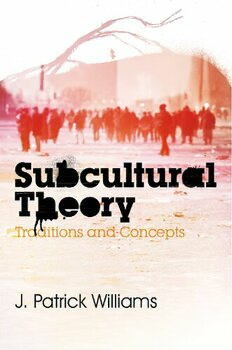
Subcultural Theory: Traditions and Concepts PDF
Preview Subcultural Theory: Traditions and Concepts
Subcultural Theory Subcultural Theory Traditions and Concepts J. Patrick Williams polity Copyright © J. Patrick Williams 2011 The right of J. Patrick Williams to be identifi ed as Author of this Work has been asserted in accordance with the UK Copyright, Designs and Patents Act 1988. First published in 2011 by Polity Press Polity Press 65 Bridge Street Cambridge CB2 1UR, UK Polity Press 350 Main Street Malden, MA 02148, USA All rights reserved. Except for the quotation of short passages for the purpose of criticism and review, no part of this publication may be reproduced, stored in a retrieval system, or transmitted, in any form or by any means, electronic, mechanical, photocopying, recording or otherwise, without the prior permission of the publisher. ISBN-13: 978-0-7456-4387-8 ISBN-13: 978-0-7456-4388-5(pb) A catalogue record for this book is available from the British Library. Typeset in 10.5 on 12 pt Plantin by Servis Filmsetting Ltd, Stockport, Cheshire Printed and bound in Great Britain by MPG Books Group Limited, Bodmin, Cornwall The publisher has used its best endeavours to ensure that the URLs for external websites referred to in this book are correct and active at the time of going to press. However, the publisher has no responsibility for the websites and can make no guarantee that a site will remain live or that the content is or will remain appropriate. Every effort has been made to trace all copyright holders, but if any have been inadvertently overlooked the publisher will be pleased to include any necessary credits in any subsequent reprint or edition. For further information on Polity, visit our website: www.politybooks.com Contents List of Figures and Images viii Preface ix 1 Subcultural Theory 1 Defi ning subculture 5 Problems theorizing subculture 8 Outline of the book 13 2 Theoretical and Methodological Traditions 17 American traditions I – the Chicago School and urban ethnography 18 American traditions II – deviance and strain 21 British traditions I – the Birmingham School and cultural studies 26 British traditions II – from the Manchester School to post-subculture studies 29 Back to subculture – the symbolic interactionist tradition 35 3 Race, Gender, and Subcultural Experience 44 From tsotsis to gangstas: “a living record” of race and masculinity 47 Negotiating the masculine bias: gender and “the master’s tools” 56 Summary 62 4 Style 65 with Jeffrey L. Kidder The meaning of style 67 From consumption to subcultural style 69 Homology: ideology, image, and practice 74 vi Contents Semiotic homologies: teddy boys, skinheads, mods, and punks 76 Ethnographic homologies: rockers, hippies, messengers, and homegirls 78 The value of style: diffusion and defusion 83 Summary 85 5 Resistance 87 Power and hegemony 89 Multiple dimensions of resistance 92 Passive ↔ active 94 Micro ↔ macro 99 Overt ↔ covert 102 Summary 105 6 Labels and Moral Panics 107 From social reaction theory to a sociology of moral panics 109 From music-lovers to satanic killers: endless cycles of subcultural folk devils 113 Raves, drugs, and postmodern media 121 Summary 124 7 Identity and Authenticity 126 Insiders and outsiders 129 Status hierarchies 133 Identity and authenticity 138 Summary 144 8 Scales 146 Sociological scales 147 Spatial scales 152 Summary 163 9 Related Fields 165 with Elizabeth Cherry Social movements 165 Collective identity 171 Lifestyle politics 173 Participatory cultures and fandom 174 Parallels 177 Tensions 180 Summary 183 Contents v ii 10 A Final Note on Concepts 185 Notes 190 References 194 Index 212 List of Figures and Images Figures 2.1 Merton’s strain theory 24 5.1 Three dimensions of resistance 94 7.1 Objectivist model of status hierarchy 135 Images 1 Girls standing outside a mosh pit at a hardcore show in Memphis, Tennessee 59 2 A bike messenger with all the typical accoutrements 81 3 A Danish punk fl yer calling for an organized protest to protect a squat in Copenhagen 168 4 Members of the 501st Legion march down the streets of Atlanta, Georgia, at Dragon*Con 179 Preface This book, while theoretically relevant to the study of most cultures marked as different from the so-called “mainstream” – whether by social status, ethnicity, language, taste, politics, or otherwise – focuses most on bringing together decades’ worth of studies on oppo- sitional youth subcultures, which became so prevalent during the twentieth century. The reasoning behind this is twofold. First, while the concept “subculture” has been used in various ways to describe the culture of many types of social groupings, its application to youth has been profound, and some of the best descriptions of young peo- ple’s alternative methods of doing things have occurred within this tradition. Second, the idea of oppositional youth subcultures is close to my own heart. It is through my participation in the punk, straight- edge, and extreme metal subcultures over more than two decades that I am the person I am today. Setting aside what I am supposed to know about primary and secondary socialization, I feel that my inter- actions with(in) these cultures during adolescence and through my adult life have been incredibly profound, leading me toward sincere critical thinking, a certain disregard for social standards or “right- ness,” and a belief in the positive possibilities for social change. Over the course of writing the text, however, I began to realize that explicitly signifying “youth subcultures” throughout the text would be counterproductive, mainly because of the diversity of types of people who participate in such cultures today. Go to a subcultural venue in almost any city and you’ll probably see more teenagers than anyone else, but there are other people to be seen as well. Subcultural affi liation is most likely to begin during adolescence, but its sig- nifi cance can last a lifetime. The concept of “youth subcultures,” so commonly used in social-science writing, rhetorically denies the
